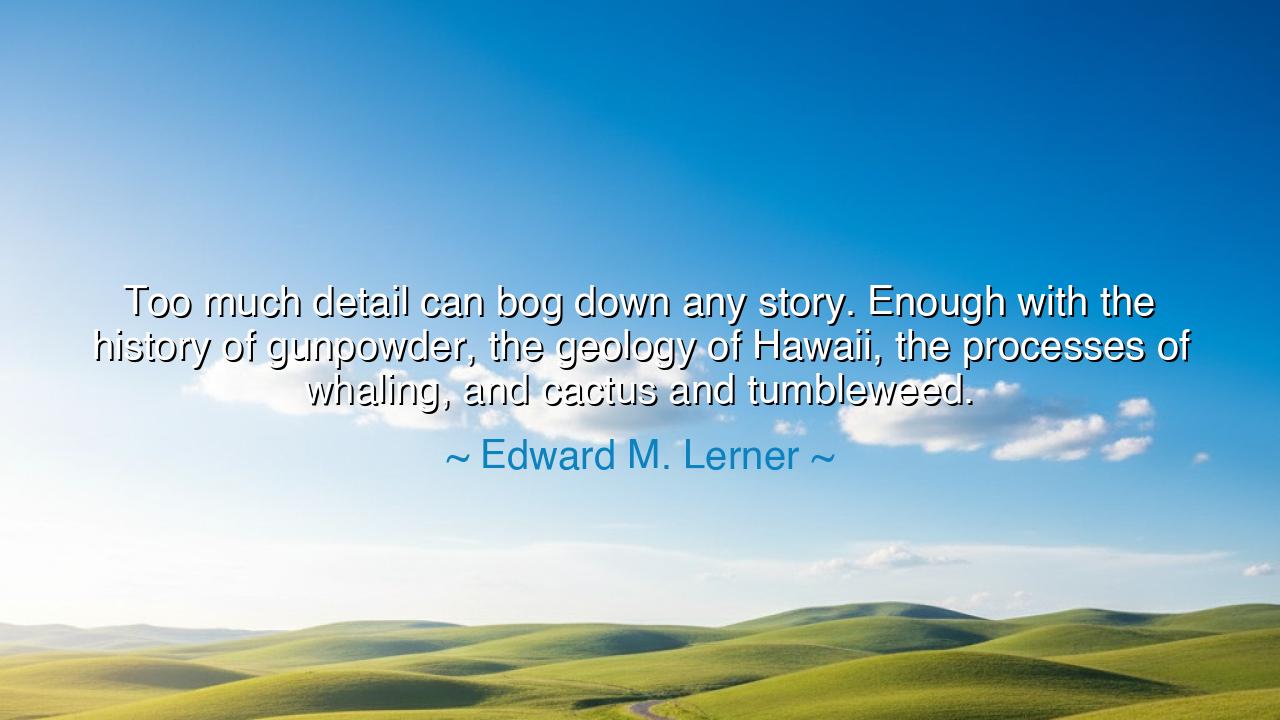
Too much detail can bog down any story. Enough with the history
Too much detail can bog down any story. Enough with the history of gunpowder, the geology of Hawaii, the processes of whaling, and cactus and tumbleweed.






“Too much detail can bog down any story. Enough with the history of gunpowder, the geology of Hawaii, the processes of whaling, and cactus and tumbleweed.” — Edward M. Lerner
Thus spoke Edward M. Lerner, the master of science fiction and reason, who understood that in both literature and life, clarity is the soul of meaning. His words, though clothed in the humor of a writer’s lament, bear the weight of deep wisdom. For he warns us that detail, when uncontrolled, becomes not a servant of truth but a tyrant of distraction. The storyteller who drowns his reader in endless explanation loses the heart of his tale, just as the thinker who obsesses over minutiae forgets the purpose of his vision. In this simple saying, Lerner speaks of more than writing — he speaks of balance, of knowing when enough is enough.
When he says, “Too much detail can bog down any story,” he reveals the eternal struggle between the craftsman and his creation — between the desire to reveal all and the discipline to reveal only what matters. The novice writer, eager to impress, fills his pages with the history of gunpowder, the geology of Hawaii, and the processes of whaling — hoping that abundance will be mistaken for depth. Yet, like a garden choked with weeds, the beauty of the narrative is lost. True art, Lerner reminds us, lies not in the fullness of knowledge, but in the precision of expression. The wise storyteller gives enough for the imagination to bloom, and then steps aside to let the reader’s soul wander.
This truth has been known since ancient times. The philosopher Laozi wrote, “To gain wisdom, one must subtract.” The sculptor Michelangelo once said he did not carve statues, but simply removed the marble that hid them. So too must the writer — and indeed, every creator — learn the art of removal, of restraint. For too much detail, too much ornament, too much explanation, is the weight that sinks the ship of meaning. Whether one writes a tale or builds a life, every addition must serve purpose, or it becomes clutter.
Consider the story of Herman Melville, whose great novel Moby-Dick stands as both triumph and warning. Within its pages lies the thunder of obsession, the poetry of the sea — and, too, entire chapters on the anatomy of whales, the history of whaling, and the classification of ships. Some readers revere it; others grow weary and turn away. Melville’s ambition was vast — his passion undeniable — yet even his genius illustrates Lerner’s truth: that when detail overshadows emotion, the heart of the story fades. Passion must be tempered by clarity, and knowledge by wisdom.
But this lesson extends beyond the realm of writing. In life itself, we are often tempted to fill our days with excess — endless tasks, possessions, information — believing that abundance equals worth. Yet the spirit grows weary beneath such weight. The man who fills every moment leaves no room for reflection. The woman who clings to every detail forgets to see the whole. As the ancients taught, the cup that is too full cannot receive new water. So too must the mind, the artist, the human heart, learn the discipline of emptiness, the elegance of leaving space.
When Lerner cries, “Enough with the history of gunpowder… enough with the cactus and tumbleweed,” he speaks with both wit and reverence. He is not scorning knowledge, but urging purpose. Every detail, he says, must serve the story’s life. A storyteller’s duty is not to impress with facts, but to move the soul — to bring the reader from darkness to light, from ignorance to wonder. In that movement, every word matters; none should be wasted. The same holds for life itself: every choice, every action should lead toward meaning, not noise.
So, O seekers of truth and tellers of tales, take this teaching to heart: simplicity is not emptiness; it is power refined. Do not mistake clutter for depth, or verbosity for wisdom. Whether you write a story, paint a picture, build a home, or craft a life, let each part serve the whole. Speak only what must be said. Create only what must exist. For the world remembers not the one who says everything, but the one who speaks the right thing at the right time.
And so, as Edward M. Lerner reminds us, art — and life itself — is not made great by the abundance of its parts, but by the harmony between them. Leave room for silence, for mystery, for the reader’s imagination and the heart’s reflection. For in the space between words, in the quiet beyond detail, lies the true magic of creation — the moment when the mind ceases to analyze, and simply feels.






AAdministratorAdministrator
Welcome, honored guests. Please leave a comment, we will respond soon